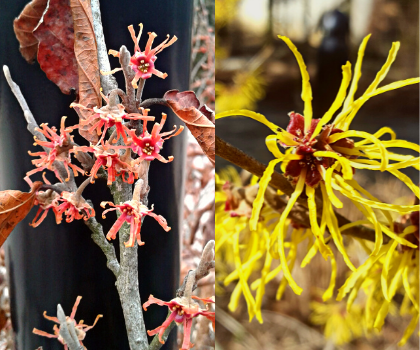“Every garden needs a witch hazel,” writes Michael Dirr, the author of several industry references for ornamental horticulture. He prefers the hybrid varieties for color and fragrance, which were developed from Japanese and Chinese species.
Witch hazels are deciduous shrubs or small trees, which means they shed their leaves every year. The name witch hazel comes from early American settlers using a forked branch of the American witch hazel as a divining rod to find underground water sources. This historic practice is commonly called “witching a well.”
We have two varieties of witch hazel at the Akron Zoo. You can find American (or common) witch hazel growing in Grizzly Ridge between the bear and the otter habitats. There is also a hybrid witch hazel called ‘Arnold Promise’ growing in Legends of the Wild across from the red-breasted geese habitat. This particular hybrid is known for its strongly scented yellow flowers.
Witch hazel plants have an open, upright appearance and are often used for borders or screening, growing to a height and spread of 12-20 ft. The leaves are roundish, 4-6 in. long, and turn yellow or orange in the fall. Flowers are 1 in. long and ribbon-like, growing in dense clusters. These fragrant, bright yellow flowers can be seen on bare stems through the winter. The plants also have a medium resistance to deer, meaning that deer will sample them when other greenery is not easily available, but they would not immediately munch on witch hazel’s leaves or flowers.
Witch hazel prefers to grow in the sun, but will tolerate semi-shade. They are also tolerant of acidic or alkaline soil. The plants should be watered in the summer and given a little mulch to help retain moisture. Pruning the twigs around the base will help the plants to grow into a more tree-like structure. Long branches can also be pruned and enjoyed indoors as a fun seasonal centerpiece.
Witch hazel also has pharmaceutical uses. You may be familiar with the bottled witch hazel sold in drugstores. This is an extraction from the leaves or bark of the plant, mixed with water and alcohol. The clear liquid can be used as a liniment for inflammation and bruising.
